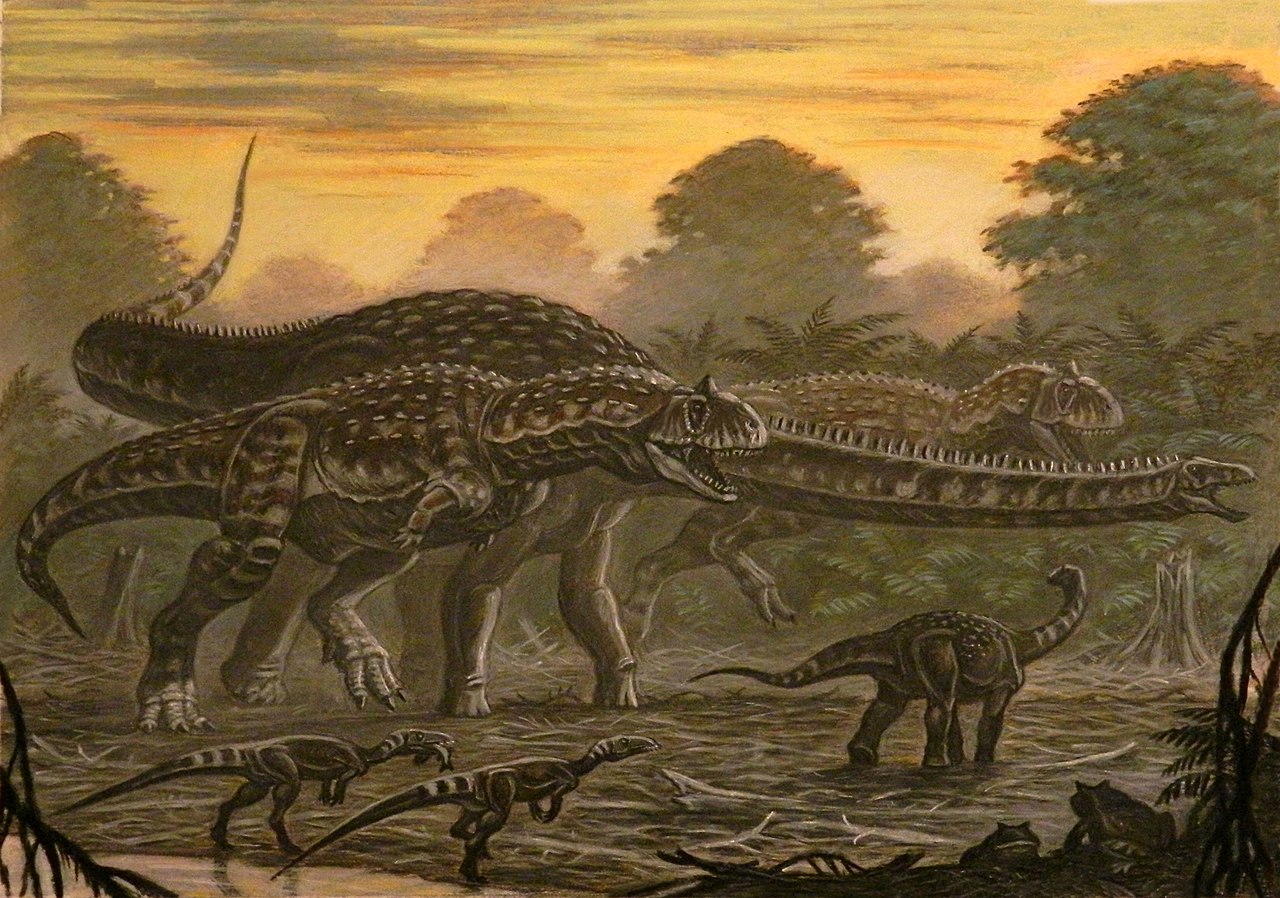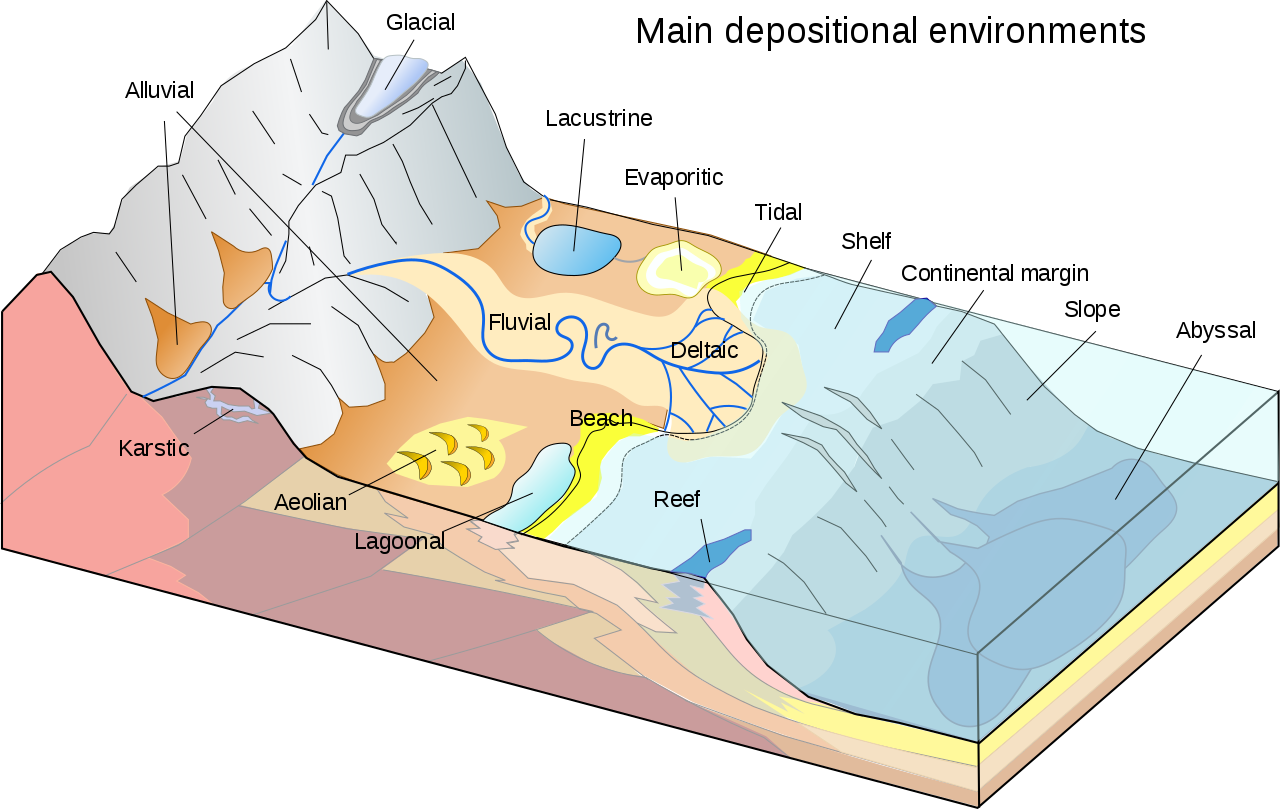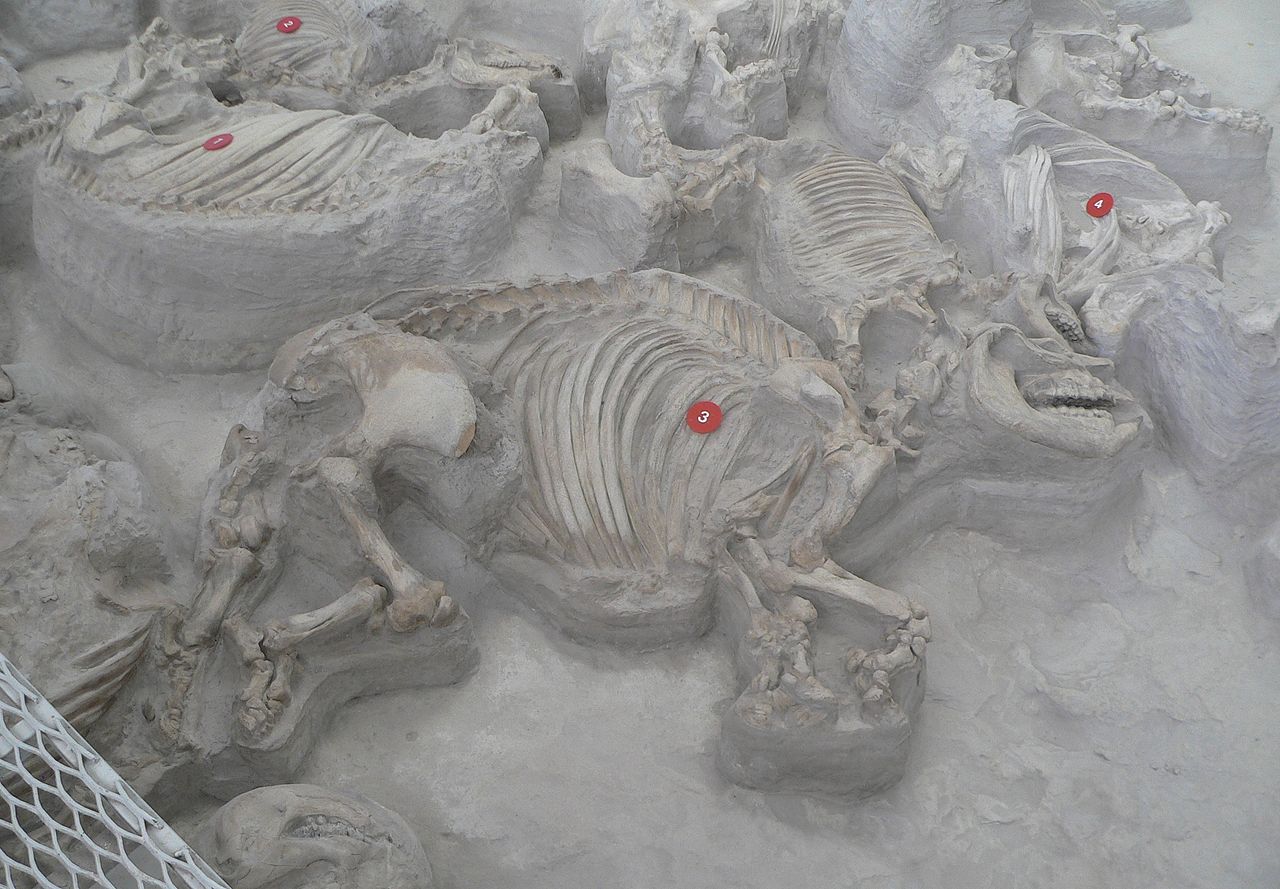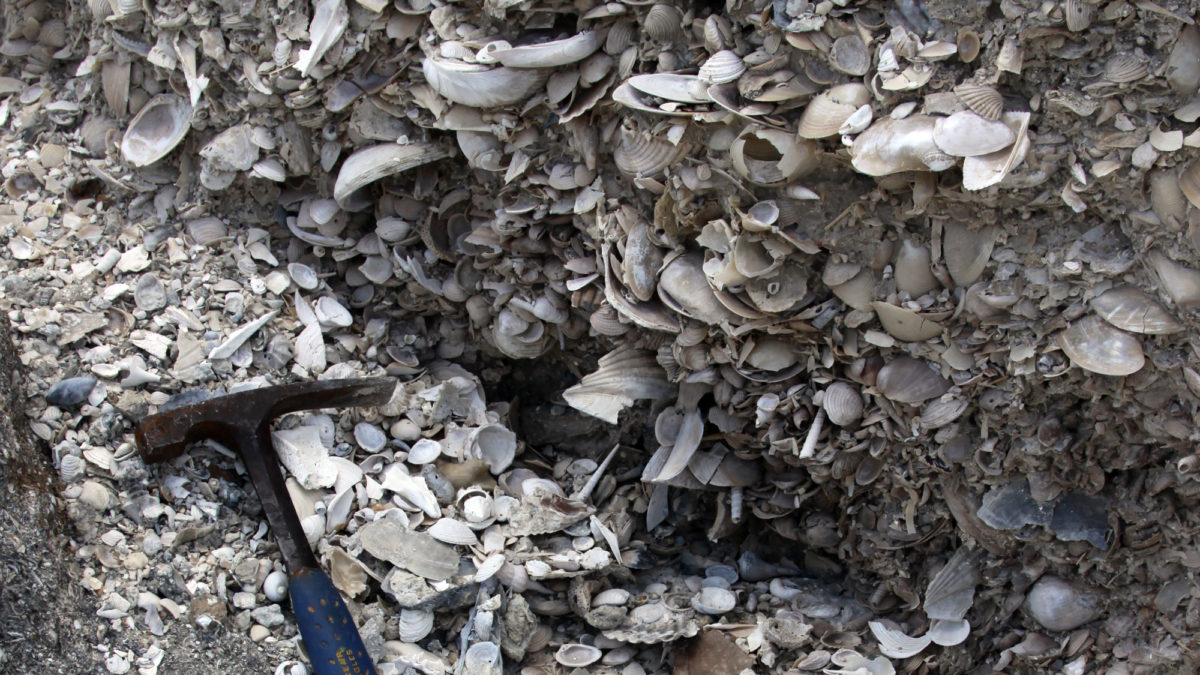Chapter by:
Jansen A. Smith, Paleontological Research Institution, Ithaca, New York
This chapter was first publicly shared on March 13, 2020.
Chapter citation:
J.A. Smith. 2020. Paleoecology. In: The Digital Encyclopedia of Ancient Life. https://digitalatlasofancientlife.org/learn/paleoecology/
Chapter contents:
Paleoecology ←
– 1. Paleoenvironmental Reconstruction
– 2. Biogeochemical Analysis and Paleoecology
– 3. Predation in Paleoecology
–– 3.1 Insect Herbivory in the Fossil Record
–– 3.2 Drilling Predation in the Fossil Record
–– 3.3 Dinosaur Predation in the Fossil Record
– 4. Paleoclimate estimation with plant fossils (section by E.J. Hermsen)
–– 4.1 Nearest living relative methods
–– 4.2 Leaf Margin Analysis
Introduction
Paleoecology is the study of interactions between once-living organisms and their environmental surroundings. Interactions between organisms can take a variety of forms, including competition between similar organisms for resources, predation of one organism by another, and symbiosis between different organisms to enable each organism to survive and reproduce. This is far from an exhaustive list, and we will explore these and other concepts in this chapter. Biotic interactions—interactions between organisms when they are/were living—are only part of the paleoecological story. Abiotic variables—non-living features of the environments where organisms live, like temperature, water depth, and amount of rainfall—strongly influence where organisms are found, how they live, and how they interact with each other. When studying paleoecology, all of these factors must be pieced together like a big puzzle to understand how life on Earth once lived.

A paleoecological reconstruction of two Majungasaurus hunting a sauropod dinosaur. Image created by ABelov2014; Creative Commons Attribution-Share Alike 3.0 Unported license.
As the name suggests, paleoecology shares many similarities with ecology, the study of living organisms and their interactions with their biotic and abiotic surroundings. Indeed, many of the theories and concepts of paleoecology have their origins in ecological studies. For example, the concept of a community—a predictable set of species co-occurring under a given set of environmental conditions—was developed by the study of living organisms well before the concept was extended to the paleontological realm. Even with this close relationship, the nature of the fossil record dictates several differences from ecology that must be considered in paleoecology.
First and foremost, a paleoecologist cannot directly observe organisms in their environments because the organisms being studied have been dead for a very long time. In contrast, ecologists can go into the world to observe the organisms they study. For example, if an ecologist wanted to understand the preferences of a bird for different types of berries, they can go watch the bird as it chooses what to eat.

A small bird, the yellow-vented bulbul, native to southeastern Asia eating small blue berries while sitting on a tree branch. Photograph by Passionatephotog; Creative Commones Attribution-Share Alike 4.0 International license.
Paleoecologists do not have this luxury. Similarly, ecologists can experiment with their organisms in the laboratory. Returning to our bird example, an ecologist has the option to capture a few of the birds they want to study, keep them in the laboratory, and offer the birds different types of berries to quantify berry preference in a controlled environment. As we’ll see later in this chapter, paleoecologists do sometimes conduct experiments with living organisms, and can learn from studies by ecologists; however, there are several complicating factors and assumptions that a paleoecologist must consider when applying concepts developed through studies of living organisms to studies of fossil organisms.
Complicating factors
Among the potentially complicating factors a paleoecologist may need to consider, taphonomy, time-averaging, and habitat mixing are often at the top of the list (learn more in the chapter on the Nature of the Fossil Record). Here we will explore these three topics as they related to paleoecological interpretations.
Taphomony
Taphonomy is a field of study concerned with the processes that affect the remains of organisms from the time the organism dies to the time it is studied—including things that happen during study! Many of these processes alter, if not destroy, organic remains. For example, when a fish dies in the ocean, a scavenger might eat it or waves from a storm might cause the skeleton to break apart. These are just two potential events among many that might occur. Collectively, this suite of processes that affect organismal remains can be compared between organisms of different species—or between individuals of the same species—as preservational bias. As discussed in the chapter on the Nature of the Fossil Record, organisms with hard parts, like bones or clam shells, are more likely to be preserved in the fossil record than organisms with only soft parts, like worms or jellyfish. Thinking of these examples, it would be accurate to say that the fossil record is biased against the preservation of jellyfish compared to clams. Many of the differences in preservational bias between organisms are much less obvious than those between a jellyfish and a clam. For example, a round snail shell and a relatively flat clam shell—both of which are made of the same basic material, calcium carbonate, and can be approximately the same size—might be more or less likely to break depending on the geological processes involved as the loose beach sediments turn into rock. From the perspective of a paleoecologist, these issues of taphonomy and preservational bias can be problematic and so it is critical that a paleoecologist tries to understand them prior to examining the interactions of the organisms in a fossil assemblage with each other and their environment. In some cases, organisms might be completely missing from the assemblage, or they might be numerically underrepresented—compared to what we would have expected if we had been able to examine the actual living community—if they were not likely to survive taphonomic processes. Usually, these types of issues do not prevent a paleoecological study, but at the very least they must be acknowledged and discussed when trying to interpret the fossil record.
Time-Averaging
Just like taphonomy and preservational bias, a prudent paleoecologist also needs to understand the extent to which the assemblage they are studying has been “time-averaged.” Time-averaging means that the individuals in an assemblage (e.g., two fossil shells found next to each other) did not live together at the same time. Instead, years, decades, centuries, or even longer periods of time may have passed between the times when the individuals were alive. To understand time-averaging, Dr. Susan Kidwell—a leading researcher on taphonomy and time-averaging—presents the issue through the analogy of picking clothing up off of a messy teenager’s bedroom floor. In this scenario, imagine a teenager comes home from school every day, changes their cloths and leaves them on the floor in their bedroom. One day this might include a nice shirt and slacks from a presentation at school, on another day maybe there are sweaty athletic clothes from gym class. At the end of the week, the clothing on the bedroom floor are all jumbled up and placed into a laundry basket.

Looking at the laundry in the baskets or on the bed, it is possible to guess the season, or how many days of clothing are represented, but identifying the cloths worn on a particular day would be very challenging. Images from WikiHow; Attribution-Noncommercial-Share Alike 3.0 Creative Commons license.
Looking at the clothing in the basket, another person might recognize some patterns. Perhaps it is wintertime, so there are several pairs of pants, long sleeve shirts, and sweaters. By looking at these accumulated articles of clothing, you could guess the season. Based on the size of the clothing, perhaps you could also guess the age and size of the teenager. There is much information to be gained from this time-averaged set of clothing. But, there are also some questions that are more challenging to answer. With no more information than the clothing in the laundry basket, would you be able to tell what the teenager was wearing on the Tuesday of the week? The answer is almost certainly “no.” The cloths are all mixed together; you probably would not even be able to tell which shirt was worn with which pair of pants.
Returning to paleoecology, similar broad patterns might be recognized, like the general habitat represented by organisms in a fossil assemblage, but finer details might not be attainable. Just as with taphonomy, these issues of time-averaging are often unavoidable but that does not mean paleoecology is futile. Instead, time-averaging can provide information about the average set of conditions over a longer period of time. For a paleoecologist, the most important thing is that the question they are trying to answer can reasonably be assessed using the data that are available. With time-averaging, just like we might not be able to figure out exactly what the teenager was wearing on Tuesday, we might not be able to figure out the exact composition of a community at any given point in time. But, like we would be able to identify the season or size of the teenager, we can understand the average composition of a community through time. The key is to ask questions that are suited to the available data.
Habitat mixing
Another important consideration for paleoecologists is the extent to which individuals from different habitats have been mixed together in a fossil assemblage. Sometimes this can happen because individuals living at or around the same time get mixed together by waves, storm events, or other forces that can move organismal remains. These processes lead to spatial mixing. Other times, the mixture of individuals from different habitats occurs as a consequence of time-averaging. That is, the individuals in an assemblage may truly have lived and died in the same geographic location but, because the assemblage accumulated over a long period of time (e.g., hundreds or thousands of years), the habitat present in that given location may have changed. For example, if sea level was to rise, what once was a shallow estuarine habitat could become a deeper continental shelf habitat.

From a sedimentological standpoint, habitats can be considered as depositional environments. Each depositional environment has unique characteristics that are observable in the geological record. For example, the Abyssal depositional environment tends to have very fine-grained sediments like clays; the Deltaic environment tends to have sands; and the Alluvial environment tends to have cobbles and boulders. As visualized by the colors on the side panels of the three dimensional image, the depositional environment in any one place can change over time, which may result in habitat mixing for fossils. Image by Mikenorton; Creative Commons Attribution-Share Alike 3.0 Unported license.
As with all the factors already discussed, this habitat mixing has the potential to change the outcomes of a paleoecological study. Often, paleoecologists will use what they know about the organisms in their assemblages to separate the organisms based on the habitats where they likely lived so that they can study the palecoecology of a single habitat. This can be important because the species in a community, and the associated biological and environmental interactions, are likely to vary habitat by habitat. Generally, when studying paleoecology, only one or a small number of factors are assessed. In order to isolate the factor of interest, it is important to keep as many other things as possible the same, like the habitat.
Key assumptions
As you may have already discovered in reading other chapters of this online textbook, like “Nature of the Fossil Record” or “Types of Fossil Preservation,” the fossil record is incomplete and there is often information missing. In addition to being selective of the questions they ask and accounting for factors like taphonomy, time-averaging, and habitat mixing, paleoecologists often also make assumptions about the organisms they are studying. Although it is generally good to minimize the number of assumptions being made, it is often not possible to avoid making assumptions all together. The assumptions made in any given study are often specific to that study and the data that are available, but there are two common assumptions we will consider here: uniformitarianism and the paleocommunity.
Uniformitarianism
Uniformitarianism is a commonly used assumption in the geological sciences based on the premise that processes and organisms in the past functioned similarly to processes and organisms we observe today. To illustrate, think about the force of gravity. You constantly experience gravity, after all, it is what keeps you grounded here on Earth, literally. Do you think organisms in the past experienced gravity like you do? Given that the mass of Earth has not changed much in the last few million years, it is probably safe to assume that, yes, previously living organisms experienced gravity just like you do today. This same principle of uniformitarianism can also be extended to processes like the deposition of sediment, taphonomy, and erosion, just to name a few. The idea of taxonomic uniformitarianism is an extension of this broader concept. Just like we can assume gravity functioned in the past as it does today, paleoecologists often assume that the organisms they observe and study in the fossil record functioned similarly to their living relatives. The more closely related two organisms are, the less uncertainty there is in this assumption. Short of having a time machine, we will likely never be 100% certain that these processes and organisms have always functioned in the same way, but much of the evidence we do have suggests that it is reasonable to assume that they have in most cases.
"Geology and Uniformitarianism" by Angie Allison. Source: YouTube.
The Paleocommunity
Another common assumption in paleoecology is that the organisms found in a fossil assemblage can be considered as a community. To understand this assumption, it is important to revisit the definitions of paleoecology and community. Paleoecology is the study of organisms and, critically, their interactions with each other and with the surrounding non-living environment. A community, as defined in an ecological sense, is a set of individuals, representing multiple species, co-occurring in space and time. Based on these two definitions—and the processes of taphonomy, time-averaging, and habitat mixing—do you think the organisms in a fossil assemblage represent a community? The answer to this question likely depends on the assemblage. Sometimes, there will be very little time-averaging, no habitat mixing, and limited taphonomy—in this case, the fossil assemblage may very well represent a real community. This type of assemblage often represents a rapid burial event where all organisms died and were buried very quickly, like the Ashfall Fossil Beds in Nebraska.

Multiple Teleoceras, an extinct genus of rhinoceros, individuals at the Ashfall Fossil Beds in Nebraska. All of these indivuals likely died at the same time and were exceptionally preserved in the ash that led to their demise. Photograph by Ammodramus; Creative Commons CC0 1.0 Universal Public Domain Dedication.
In other assemblages, organisms may have lived thousands of years apart, lived in neighboring habitats, and/or been removed completely or altered by taphonomic processes. In this second case, whether the assemblage is considered a community often depends on the questions being asked by the paleoecologist. It is relatively common to call this a “paleocommunity,” which acknowledges that individuals in the assemblage may not have co-occurred but, nonetheless, it will be assumed that they coexisted and interacted. Viewed from a slightly different perspective, a paleocommunity can be considered a recurring collection of associated species. In this second perspective—still with the underlying assumption that individuals interacted and coexisted even if this may not have been true—these associations of species are typically thought to have been from the same habitat. As with all assumptions in scientific study, there are cases where this assumption may not be appropriate and there is some debate in the field of paleoecology regarding the validity of this assumption. For the purposes of this chapter, however, we will assume that fossil assemblages do represent real, interacting communities.
Concept check: See what you know!
True or False: Many concepts in the field of ecology are based on pre-existing paleoecology concepts.
False! The opposite it true; many of the concepts of paleoecology were developed based on ecological concepts.
In what way do paleoecologists use studies of modern organisms to inform their studies?
In addition to using ecological concepts in their work, paleoecologists use observations of living organisms to understand how their long-dead organisms may have interacted. This draws on the assumption of uniformitarianism.
________ is the study of the processes that affect the remains of organisms from the time the organism dies to the time it is studied.
Taphonomy
How is a paleocommunity different from an ecological community?
A paleocommunity is time-averaged, which means the organisms in the fossil assemblage may not have actually lived at the same time.
References and Further Reading
Behrensmeyer, A. K., and A. P. Hill (Eds.). 1988. Fossils in the making: vertebrate taphonomy and paleoecology (No. 69). University of Chicago Press, Chicago, 338 pp.
Behrensmeyer, A. K., S. M. Kidwell, and R. A. Gastaldo, 2000. Taphonomy and paleobiology. Paleobiology, 26: 103-147. https://doi.org/10.1017/S0094837300026907
Bottjer, D. J. 2016. Paleoecology: Past, Present and Future. John Wiley & Sons, West Sussex, 232 pp. https://doi.org/10.1002/9781118455838
Kidwell, S. M. 2009. Evaluating human modification of shallow marine ecosystems: mismatch in composition of molluscan living and time-averaged death assemblages. Pp. 113-139, in: Conservation Paleobiology: Using the Past to Manage for the Future, G. P. Dietl & K. W. Flessa (eds.), The Paleontological Society, New Haven.
Kidwell, S. M. 2013. Time‐averaging and fidelity of modern death assemblages: building a taphonomic foundation for conservation palaeobiology. Palaeontology, 56: 487-522. https://doi.org/10.1111/pala.12042
Tucker, S. T., R. E. Otto, R. M. Joeckel, and M. R. Voorhies. 2014. The geology and paleontology of Ashfall Fossil Beds, a late Miocene (Clarendonian) mass-death assemblage, Antelope County and adjacent Knox County, Nebraska, USA. Field Guides, 36, 22 pp.
Usage
Unless otherwise indicated, the written and visual content on this page is licensed under a Creative Commons Attribution-NonCommercial-ShareAlike 4.0 International License. This page was written by Jansen A. Smith. See captions of individual images for attributions. See original source material for licenses associated with video and/or 3D model content.




